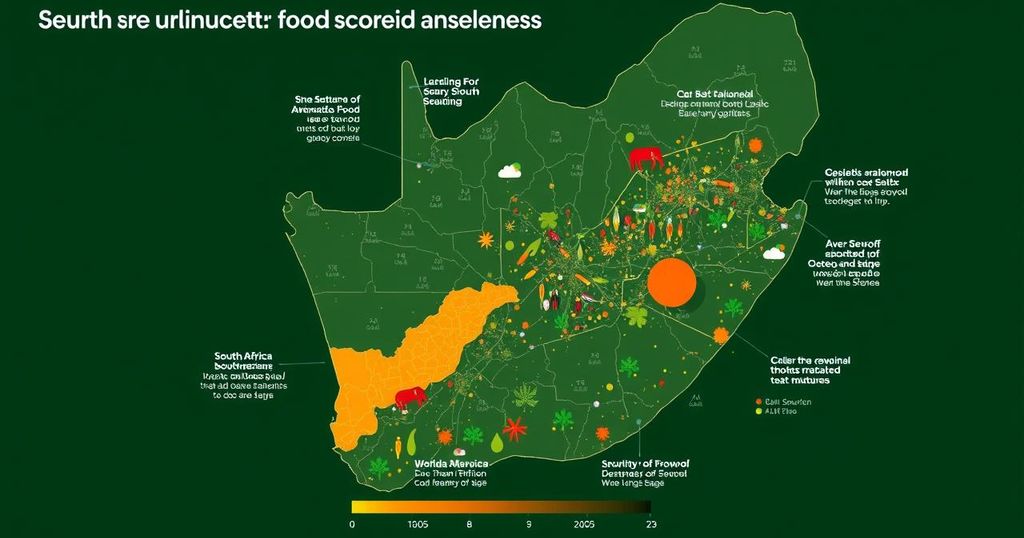A 2023 report reveals that food security in South Africa is critically low, with 25% of poor households reporting child hunger. Child stunting rates are nearly equal to those in Zimbabwe, with approximately 4.7 million citizens unable to meet basic caloric needs. The South African Food Security Index has fallen sharply, indicating deeper levels of insecurity than in prior years, exacerbated by economic pressures and inflation. Provinces vary in food security resilience. Experts call for better alignment between food affordability and nutrition, suggesting VAT exemptions for healthier food options as a potential solution.
Recent findings from a Stellenbosch University report indicate that food security in South Africa has reached alarming lows, with statistics revealing that 25% of the poorest households reported that children went hungry in 2023. Although South Africa enjoys relatively greater wealth than its neighbor Zimbabwe, it faces persistent challenges, with child stunting rates at 25%, closely trailing Zimbabwe’s rate of 23.5%. Moreover, approximately 4.7 million South Africans struggle to meet their basic caloric intake. The report highlights that female-headed households encounter the highest risks of hunger, with 16.7% in rural areas and 11.9% in urban centers reporting hungry children, compared to 12.5% and 8.7% in male-headed households, respectively. The South African Food Security Index for 2024 has plummeted to 45.3, a stark decrease from its peak of 64.9 in 2019. This decline signifies that more individuals experienced severe food insecurity in 2023 than in any other year from 2012 to 2023. Additionally, dietary variety has diminished, with 11.8% of households consuming fewer food types due to economic constraints. Although hunger levels saw a decrease in 2007, significant crises like the financial downturn of 2008 and recent global challenges have exacerbated food insecurity, leading to rising hunger levels post-Covid. The report identifies regional disparities, noting that provinces such as Limpopo displayed unexpected resilience in food security, while the Northern Cape experienced a grave decline, dropping from the 2019 index’s 40-50 range down to 10-20 by 2023. Overall, the index suggests that without prompt intervention, food insecurity in South Africa could deteriorate further over the next decade. Professor von Fintel addressed the media about the intertwined issues of economic hardship and soaring food inflation, emphasizing that food price increases have significantly outpaced general inflation rates. He remarked on how households are compelled to allocate their limited resources toward other pressing financial demands, often leading them to purchase cheaper yet less nutritious foods. He stated, “This is a core part of our index… food inflation is far more rapid than general inflation.” In advocating for better food accessibility and nutrition, Von Fintel indicated that it is crucial to align affordability with nutritional value. He highlighted that nutritious yet affordable food options exist, such as chicken liver and dark leafy vegetables. Furthermore, he pointed out the necessity of revising VAT policies to favor more nutritious food products. The South African Poultry Association has reiterated the call for the Treasury to exempt specific chicken products from VAT to support low-income households, a move that could bolster the poultry industry’s sustainability. Concerns over high food costs continue to be echoed by the Competition Commission, which has observed that while food cost pressures are diminishing, retail prices have not been adequately adjusted to reflect these savings.
Food security remains a critical issue globally, particularly in countries like South Africa where structural inequities and economic challenges persist. Recent reports illustrate a troubling trend in food insecurity despite South Africa’s status as a comparatively wealthy nation. The implications of child malnutrition and household hunger have been profound, impacting future generations and overall public health. Economic factors such as inflation and the ongoing repercussions of the Covid-19 pandemic continue to exacerbate these challenges. The South African Food Security Index serves as a key measure for assessing the state of food availability, access, and utilization across the country, providing vital insights into regional disparities and the effectiveness of government interventions.
In summary, South Africa’s food security landscape is increasingly concerning, with significant portions of the population, particularly children, experiencing hunger and nutritional deficiencies. The decline in the Food Security Index signals deeper issues that may worsen in the absence of effective policy interventions, especially regarding inflation and food affordability. Collaborative efforts to promote nutritious and accessible food options are essential to mitigate the growing crisis. As experts indicate, immediate action is required to realign food policies to ensure the well-being of vulnerable households and to sustain the nation’s food security into the future.
Original Source: www.dailymaverick.co.za






